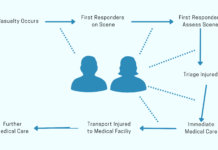Of the many significant forces shaping the U.S. economy—including globalization, automation, and housing supply—none is so inevitable and invisible as the sheer march of time for today’s adults. In the 1950s, at the height of the U.S. manufacturing supremacy, less than 10 percent of the country was older than 65. That share will double to 20 percent by 2050. The greying of America will touch every station of economic and political life: the size of the labor force, the jobs the economy will require, the ethnic makeup of the country, and the productivity of the workforce.
Start with the economy. First, as a workforce ages, it becomes less productive. Economists aren’t sure why, but a recent study found that a 10 percent increase in the fraction of the population ages 60+ “decreases the growth rate of GDP per capita by 5.5 percent.” Slowing productivity growth will be particularly challenging because as the country gets older, a larger share of the native born population will be retired. Medicare, Social Security, and other programs for the elderly require lots of tax income from a large and vibrant working force.
The aging of the population will also change the kinds of jobs Americans will do. Although both parties occasionally like to pretend that manufacturing is the backbone of the U.S. workforce, manufacturing jobs are projected to decline by one million jobs in the next ten years. The fastest growing occupations of the next decade are all in health—personal care aides, registered nurses, and home health aides. These jobs couldn’t be more different from the prototypical mid-century steel worker. Underpaid and without a strong union, home health aides make an average wage of about $23,000, according to the New York Times’ Binyamin Appelbaum. “Instead of white men who make stuff, the group is increasingly made up of minority women who serve people,” he writes. Indeed, immigrants account for almost a third of the in-home health-care workforce, and one in five of them are undocumented, by one estimate.
Does the inevitable aging of America carry obvious public-policy recommendations? The need for home health aides should factor into the conversation about immigration, yet I have heard nothing on the campaign trail about how the fastest growing occupations in the U.S. currently relies on a steady supply of immigrants. The rise in health-care spending for the elderly will force debates about the most humane and affordable way to care for those who need it. As Americans live longer, poor and middle class retirees will need more savings. The U.S. government could discuss an expansion of Social Security for the poorest, or new ways to force—or “nudge”—even low-income Americans to save enough money to last their extended lifetimes.
Analysis
This article looks at the effects of an increasingly aging population on the U.S. economy. Written just before the 2016 presidential election, it takes on an economist’s perspective of how an increase in retirees in the coming years might affect the ways politicians campaign and create public policies, particularly about America’s economy. It also notes which kinds of jobs are predicted to become less prevalent (manufacturing), and which will become more prevalent (unsurprisingly, jobs related to healthcare for an aging population). My initial research has often led me to sources that say that older adults often like having something in their life that gives them a sense of purpose, which is often something they lack after retirement. Though I don’t think the aging population should not be required to get new jobs after retirement, this article does make me wonder what kinds of opportunities there are for older adults to serve a new role in society at this stage in their life, whether it is economically beneficial or not.




